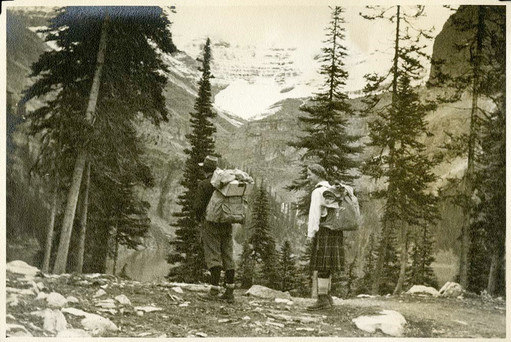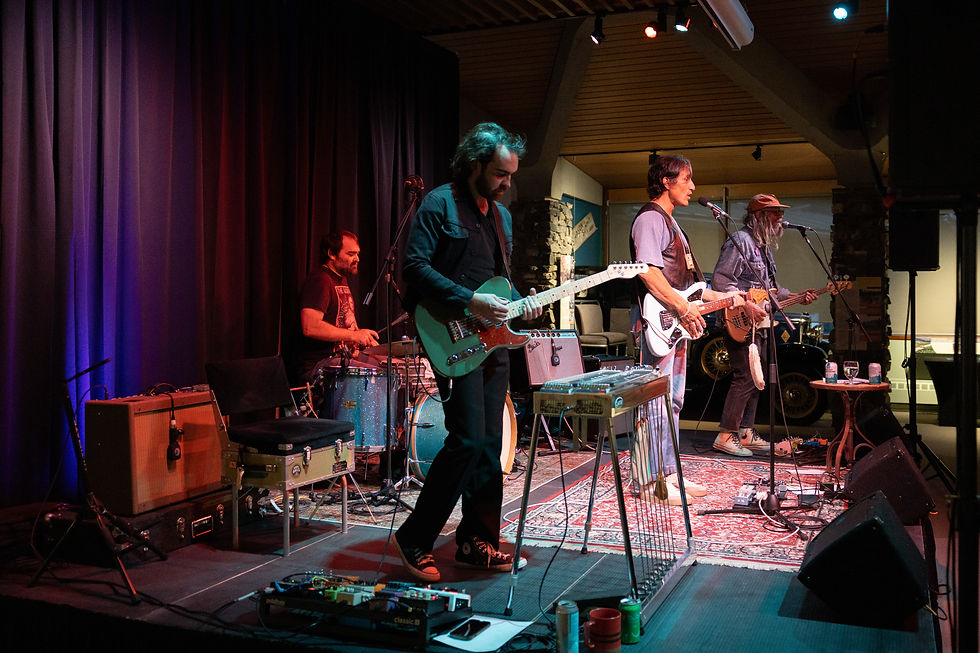Dispatch from the Whyte home: Backpacking Gear Through the Ages
- Aug 19, 2020
- 5 min read
Updated: May 1, 2024
By Amie Lalonde, Registrar & Assistant Curator
Hello from the Whyte Home! Since finishing up in the Moore Home I’ve started cataloguing the home of the museum’s founders: Peter Whyte and Catharine Robb Whyte. The Whyte home is newer than the Moore home (it was built in 1930–1931 and renovated several times between then and 1959) but it still has the same cozy cabin vibe as the Moore home. The spirits of Pete and Catharine are still very much alive in their home and every room is chock full of art, artifacts, and books that showcase their love for travel, art, and the wonderful landscapes of the Canadian Rockies.
As we all adjust to what will mostly likely be the strangest summer of our lives many of us are spending more and more time outside, physically distancing, and enjoying nature. With camping season well underway I thought I’d take you through a selection of gear that is simultaneously familiar and very different to what we have today. All of the gear in the article below is stored within the built in benches in the dining area in the Whyte home. This home is full of clever storage solutions like this to make the most of the space.

From painting en plein air at Lake O’Hara to skiing the Skoki Valley, both Pete and Catharine spent an enormous amount of time exploring the mountains much like residents of the Bow Valley and thousands of visitors still do each year. The gear that Pete and Catharine wore and carried is in some ways vastly different to the gear that we carry today. Some gear is similar — there’s only so many improvements that can be made to a stainless steel cup, plate, or cutlery set (though the spork had yet to be invented!). However, the most important pieces of gear — shoes, backpack, sleeping gear, and clothing, has changed immensely. The most notable differences in gear then versus now are: weight and waterproofing. Today’s backpackers wouldn’t even think about going into the backcountry without Gore-tex and consider weight down to the gram when choosing gear. In Pete and Catharine’s day gear was heavy, wool and canvas were the main materials used in backpacks, sleeping bags, and clothing.
Below are two of Peter and Catharine’s backpacks. Both are heavy canvas with triangular frames on the back. Also below is an archival photograph (V683 / III / A / 15 / PA - 184) of Peter and Catharine hiking with full packs.


In this archival photograph you’ll also notice the studded boots both are wearing. These “hobnail” boots had thick leather soles with short, thick-headed nails driven into the sole for traction and durability. These were used by hikers and mountaineers before the advanced mountaineering and hiking boots that we rely on today. Visit the museum for an up close view of a pair of these boots in our heritage gallery!
Above Left: Backpacks, 103.08.0324 and 103.08.0329.
Gift of Catharine Robb Whyte, Banff, 1979.
Above Right: Peter Whyte and Catharine Robb Whyte hiking, Peter and Catharine Whyte fonds, Whyte Museum of the Canadian Rockies (V683/III/A/15/PA-184)

Above: Peter and Catharine Whyte on hike, resting on slope [c. 1930s], Peter and Catharine Whyte fonds, Whyte Museum of the Canadian Rockies (V683/III/A/15/PA-833)
What was inside Peter and Catharine’s packs? Much of their gear around the campfire is pretty similar to what we still use today, if only a tad more rustic.

Above: Image of (left to right) Catharine Whyte, Adeline Link, J. E. H. MacDonald, Peter Whyte posing for a photograph on a hike - "The Opabin Shale Splitters", Peter and Catharine Whyte fonds, Whyte Museum of the Canadian Rockies (V683 / II / B / PA - 49)
Below is a selection of their dishes, cookware, and camp accessories including: salt and pepper shakers (one made from a Kodak film canister), a foldable lantern (centre), a box of fire starters, stacking cups and bowls, a set of stacking cooking pots, a thermos, and different variations of camp cutlery. One thing that struck me most when looking at their food and beverage accessories was the weight of some of it. While everything below is rather light, they had a variety of very heavy thermoses that were all obviously well-used.

From left to right:
Stainless Steel Thermos (104.20.0730): 714g
Thermos with red cup cap (104.20.0732): 407g
Pair of Sterling Thermoses with cup caps and leather case (104.20.0727 a-c): 417g, 510g, 541g (case)
Stanley vacuum bottle with cup cap (104.20.0728): 1.4lbs
That last one is not a typo, this thermos is extremely heavy. At this weight I doubt this thermos was used on backpacking trips but it is obviously well used and was possibly a road trip or car camping companion.
Below is a sleeping bag, or rather, a “down-filled sleeping robe”. While this is the smallest of the three sleeping bags I have come across thus far in the Whyte home it is still quite bulky and heavy. While it is possible that Peter or Catharine carried this in (it is advertised as for “mountaineers” after all), I suspect it was most likely carried by horse or used solely on car-camping trips.
Above: Sleeping bag, 103.08.0469. Gift of Catharine Robb Whyte, Banff, 1979.

For a gear comparison, here is a photograph of everything I carried on my back for a recent camping trip to Lake O’Hara. My 55 litre bag weighed 42lbs with gear, clothing, food (not pictured), and a full hydration bladder – I very much did not pack light on this trip. My stainless steel pot in the centre wouldn’t have been out of place in Peter and Catharine’s packs but nearly all of the other gear would have been foreign to them. From the size of my sleeping pad (the yellow bundle) and sleeping bag (upper left) to the waterproof stuff sacks that hold my clothing and food – the advances in camping gear make for much lighter and weather resistant packs now.
Last but not least, clothing! One of Catharine’s signature hiking looks involved this beautiful kilt, shown in archival photos below and currently on display in our heritage gallery. Other clothing includes wooden pants and jackets, brimmed hats, high socks, and enough tweed to outfit a history faculty lounge 10x over. Definitely a far cry from the brightly coloured Gore-tex and down jackets we employ against the elements today.

Above: Kilt, 103.05.0125, c. 1935-1950, Gift of Catharine Robb Whyte, Banff, 1979. Seen inside the Heritage Gallery at the Whyte Museum of the Canadian Rockies, Banff
Left: Peter Whyte, Catharine Whyte wearing backpacks and hiking with Victoria Glacier in background [c. 1930], Peter and Catharine Whyte fonds, Whyte Museum of the Canadian Rockies (V683/III/A/1/PD-1/70/001)
Right: Unidentified hikers, [ca. 1930 to ca. 1936], Peter and Catharine Whyte fonds, Whyte Museum of the Canadian Rockies (V683/III/A/5/PA-96)
If you’re interested in a further look at old gear, check out this video where a group of amateur climbers set out to re-enact the 1916 ascent of Bugaboo Spire in BC’s Purcell Mountain Range using the very gear and clothing that those first climbers would have used a hundred years ago.
That’s all for now, I hope you enjoyed this look at the camping gear that was used 90 years ago and that it gives you something to think about as you’re out on the trails this summer.
Stay tuned for more dispatches from the Whyte Home in the coming months!















Comments